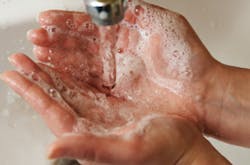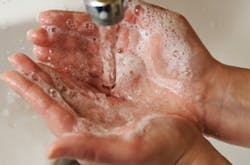Dental infection control: Hand Hygiene
DID MOTHER REALLY KNOW BEST?
BY MARIE T. FLUENT, DDS
My mother, Betty Lou Yura, taught me a great deal, and over time proved to know what was best in many areas of life. Unfortunately, hand hygiene was not one of them. Mom knew the basic principle with regard to hygiene — “cleaning hands removes the germs.” However, she harbored several misconceptions and peculiar methods with regard to hand washing, and was not shy about sharing them. Despite her unconventional beliefs and atypical methods, my mother was generally healthy, lived a long life, and did not depart this world due to a health-care associated infection.
She stated repeatedly with conviction, “A few germs will never kill you.” She was not aware that hands are a common mode of transmission for infections. Nor was she aware that routine hand hygiene is considered the single most effective measure for reducing the risk of transmitting infections in health-care settings.1 Before you think I’m besmirching my late mother’s good name, it should be noted that she was not a health-care provider, and thus should not be held to the same standard.
Here is an analysis and comparison of hand hygiene practices, as recommended by the “Betty Lou Yura Guide to Healthy Hand Hygiene,” contrasted with a reputable information source, “The 2002 CDC Guideline for Hand Hygiene in Healthcare Settings” for health-care providers.
- “A few germs will never kill you” — My mother was a teacher and kept busy raising four children. Thus, a few germs on Mom’s hands were probably acceptable, and it was unlikely that her hands were a mode of transmission for infections. However, her basic attitude toward hand hygiene was not adequate for the health-care environment. Research has shown that high numbers of health care-associated infections (HAIs), including the spread of multiresistant organisms, result from poor compliance with hand-hygiene practices, and organisms on the hands of health-care practitioners are responsible for many of the over two million HAIs each year in the U.S.2 While the primary purpose of hand hygiene is to remove transient microorganisms from the skin (I believe my mother intuitively knew this), the ultimate goal is to prevent cross contamination and cross infection from contaminated hands.
- “You only need to wash your fingertips” — In her typical practice of hand hygiene, Mom would merely wash her fingertips. Her reasoning, “Those are the only areas that really get dirty.” In addition, my mother’s hand-washing sessions lasted five seconds at the most. Sorry, Mom, this method isn’t effective or adequate for health-care professionals. Correct hand antisepsis includes covering all areas of the hands with the cleaning agent for a proper length of time.
Specific steps are required for hand hygiene in a health-care setting. The first wash of the workday should include a thorough hand wash lasting at least one minute. Subsequent hand hygiene procedures should last 15 to 20 seconds (or the time recommended by the manufacturer). Hands must be wet and an adequate amount of soap should be applied. Then hands should be rubbed together vigorously, covering all surfaces of the hands and fingers, followed by thorough rinsing and drying with a disposable towel.
If hands are not visibly soiled, alcohol hand rubs may be used. With this method, the product is applied to dry hands and the hands are rubbed together, covering all surfaces for at least 15 to 20 seconds until the hands are dry. It is important to follow the manufacturer’s recommendations regarding the quantity of product to apply. If hands are dry after 5 to 10 seconds, it is likely that too little product was used.3
- “Any soap or detergent is fine” — My mother washed her hands with any soap-like product that was at her fingertips. On many occasions, I witnessed her performing hand hygiene with household detergents. This may or may not be appropriate for home use. However, products available for health-care providers include plain soap, antimicrobial soap, and alcohol hand rubs. Clinicians may choose any of these agents, yet if hands are visibly soiled, alcohol hand rubs may not be used. This is because alcohol does not “clean” hands. Alcohol is an excellent antimicrobial agent as it denatures and dehydrates proteinaceous materials on hands, and thus may be used on “visibly clean” hands only.4
Of all the products available, the recommendation is to use those that have been manufactured for health-care providers. These products are generally unscented, have few allergenic components, and contain emollients, such as glycerin or aloe, to soften hands and protect the epidermal integrity. These products are also more rigorously tested, meant for repeated usage throughout the workday, and are actually gentler on hands than those for occasional home use.5
- Scalding water: “If it is killing your hands, think what it is doing to germs” — On rare occasions when Mom did engage in a thorough hand wash, she believed that hotter water was superior. However, with repeated hand hygiene throughout the clinical day, temperature extremes (hot or cold) may lead to dry, cracked, and chapped hands, and can discourage thorough rinsing. Temperature extremes, hand hygiene product residues, and incomplete drying of hands may lead to an increased risk of dermatitis.6 Remember that an intact epidermis is a first line of defense in infection transmission; thus it is recommended to wash with cool or tepid water and rinse thoroughly.
- “You only need to wash before cooking and after using the restroom” — In Mom’s daily routine this may have been partially true. However, there are more indications for hand hygiene with dental clinicians throughout the workday. These include before donning gloves, after glove removal, before eating, after restroom use, and anytime gloves are compromised and need to be changed. Hands must also be cleaned after touching contaminated surfaces or instruments.
- “Who needs hand lotions? A nightly application of Bag balm will do the trick” — The use of lotions is recommended for health-care workers to help prevent skin dryness associated with frequent hand washing. Petroleum and oil-based products can weaken latex and nitrile glove integrity and increase permeability; therefore they should be used only at the end of the workday. However, water-based lotions are recommended for repeated use over the course of the clinical workday. These products are specifically manufactured for health-care practitioners and are generally compatible with glove usage. They also contain fewer scents that may be offensive or allergenic to clinicians and patients.
- Short fingernails? No problems here! — Mom was health-care compliant with her short, rounded nails that were free of polish. I must commend her for this practice, as artificial and long nails make donning and removing gloves more difficult and make tears in gloves more likely. It has been shown that bacterial counts are higher on hands with artificial nails and on nails with chipped polish.7 Jewelry may also compromise the fit and integrity of gloves and increase bacterial counts on hands. Thus, the wearing of hand and arm jewelry while providing routine dental treatment is strongly discouraged, and it is prohibited during surgical procedures.
Without question, in the realm of hand hygiene, my mother harbored several misconceptions and engaged in a range of peculiar methods. If she worked in my office today, I would insist that she learn and understand the importance of hand hygiene for health-care providers. I would educate her on the effectiveness of hand hygiene in the prevention of disease transmission. I would teach her the proper methods of washing her hands, and I would demonstrate various products available for hand hygiene that are effective yet gentle.
I say all this recognizing that she would likely be noncompliant, require constant supervision, and would be a “high maintenance employee.” Regardless, following my likely futile efforts to “educate” her, I would be inclined to hug her and thank her for teaching me all the things in life that matter most. These are far too numerous to describe in a single article. RDH
References
1. CDC. Guideline for Hand Hygiene in Health-Care Settings, 2002. MMWR. 2002; 51 (RR-16): p. 2.
2. Andrews, Cuny, Molinari, Harte. Antisepsis and Hand Hygiene. In: Molinari JA. Practical Infection Control in Dentistry. 3rd ed. Philadelphia, PA: Lippincott, Williams, and Wilkins; 2010: 125-137.
3. CDC. Guideline for Hand Hygiene in Health-Care Settings, 2002. MMWR. 2002; 51 (RR-16): p. 32.
4. Molinari JA. Clinic experiences with waterless alcohol-based hand hygiene antiseptics. Compend Contin Educ Dent 2006; 27: 84-86.
5. Andrews, Cuny, Molinari, Harte. Antisepsis and Hand Hygiene. In: Molinari JA. Practical Infection Control in Dentistry. 3rd ed. Philadelphia, PA: Lippincott, Williams, and Wilkins; 2010: p. 133.
6. Andrews, Cuny, Molinari, Harte. Antisepsis and Hand Hygiene. In: Molinari JA. Practical Infection Control in Dentistry. 3rd ed. Philadelphia, PA: Lippincott, Williams, and Wilkins; 2010: p. 127.
7. Hedderwick SA, McNeil SA, Lyons MJ, et al. Pathogenic organisms associated with artificial fingernails worn by healthcare workers. Infect Control Hosp Epidemiol 2000;21:505-509.
MARIE T. FLUENT, DDS, is a graduate of the University of Michigan School of Dentistry. She has enjoyed over 20 years of dentistry and is in private practice in the greater Ann Arbor community. Dr. Fluent is an adjunct clinical lecturer for the University of Michigan and a faculty member and a clinical instructor in the dental assisting program at Washtenaw Community College. Dr. Fluent is an infection control consultant with the Ann Arbor VA hospital. She is an assistant editor for The Dental Advisor and lectures and presents hands-on workshops on the topics of dental materials and infection control in the dental office.
Past RDH Issues

